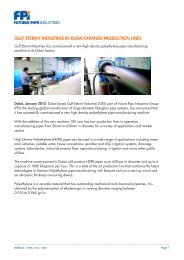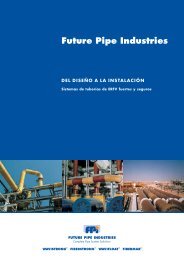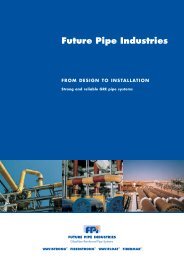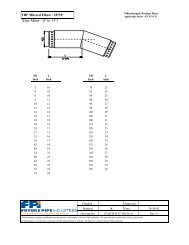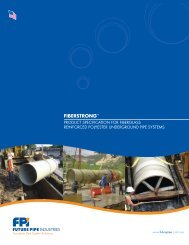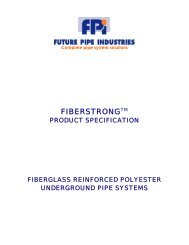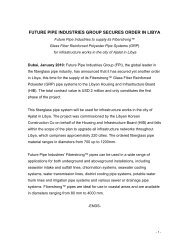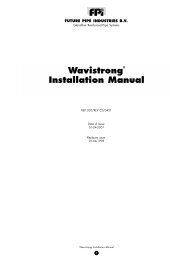Untitled - Future Pipe Industries
Untitled - Future Pipe Industries
Untitled - Future Pipe Industries
You also want an ePaper? Increase the reach of your titles
YUMPU automatically turns print PDFs into web optimized ePapers that Google loves.
Mechanical lowering is used for larger diameter pipes, especially when combined with pipe assembly in the trench. A<br />
strap or a sling can be used from an excavator boom if no separate lifting equipment is available.<br />
Caution: Under no circumstance should brute force be applied to mount the coupling. The pipes and couplings are dimensioned<br />
within close tolerances that allow jointing to be carried out without using excessive force.<br />
Working with mounting equipment, although very efficient, should not be carried out by unskilled laborers. Risks of damaging<br />
or dislodging a rubber ring should not be disregarded. It is essential to push the coupling to the home line and not<br />
more, otherwise the pipes in the coupling will touch each other and will consequently not allow for any expansion or<br />
deflection inside the joint. Only skilled operators should attempt to use the boom of an excavator to push either coupling or<br />
pipe, as the direction of the applied force is not under control and might damage the pipes and/or the coupling. No steel<br />
tools should come into direct contact with the edges of the pipe or its external surface. <strong>Pipe</strong> edges should be protected with<br />
a timber.<br />
Figure 11: Mechanical lowering with excavator<br />
5.4: Offshore intake and outfall lines<br />
This installation method is used for the offshore portion of seawater intake/outfall pipes. The pipe joints are normally<br />
assembled under the water. Steel angle irons lugs will be laminated on the two ends of pipe to allow divers to assemble<br />
the standard Reka coupling joints under water using stud bolts and nuts (supplied by contractor). It may be possible to<br />
assemble on the barge up to 3 x 40 ‘ lengths of pipes and to lower the assembled section (total length of 120 ft) into the<br />
excavated sea bed trench.<br />
Caution: Standard Fiberstrong FRP pipe is not designed to be assembled on-shore in long lengths and then dragged out<br />
to the sea.<br />
Installing pipe under water requires a trench similar to the onshore trench, excepting that the trench width is larger. The typical<br />
underwater trench width is equal to 2 x DN, but in no case less than DN + 4 ft. The cover over the pipes shall be not<br />
less than 3.5 ft above the pipes to the normal seabed.<br />
The divers should backfill with excavated granular seabed material in maximum 12” lifts, paying particular attention to the<br />
backfilling and compaction of the backfill under the pipe haunches. Backfilling should be made evenly on both sides of the<br />
pipe to avoid displacement of the pipes.<br />
Protection shall be provided for the backfilled seabed over the pipe trench. Large stones or rocks (rip-rap) may be used for<br />
this purpose.<br />
22



